About Us
Vishwawalking explained
 Ratings Explained
Ratings ExplainedVishwawalks
Day walks
Food
Funky Places
Future walks
Gear
Get Lost
Good reads
Links
Right to Ramble
Site map
Contact us
Vishwawalking
Lakefield Cement Factory
Click
here or on any photo for more photos of the cement factory
Cement and concrete, it should be mentioned, are different substances. Concrete is made from different types of gravel (aggregate) which is then bonded with cement and water. Cement is the glue that keeps it all together.
Cement has been around as a compound since the Babylonians used clay to bond with other material. In 1756, Englishman and engineer John Smeaton developed the first modern concrete (hydraulic cement). In 1824, Joseph Aspdin, an English inventor, came up with Portland cement. He mixed burned ground limestone and clay to produce "artificial cement." The burning produced stronger cement than could be produced using plain crushed limestone.
Lakefield Portland Cement Company/Canadian Portland Cement Company
Cement and concreteCement and concrete, it should be mentioned, are different substances. Concrete is made from different types of gravel (aggregate) which is then bonded with cement and water. Cement is the glue that keeps it all together.
Cement has been around as a compound since the Babylonians used clay to bond with other material. In 1756, Englishman and engineer John Smeaton developed the first modern concrete (hydraulic cement). In 1824, Joseph Aspdin, an English inventor, came up with Portland cement. He mixed burned ground limestone and clay to produce "artificial cement." The burning produced stronger cement than could be produced using plain crushed limestone.
Some history
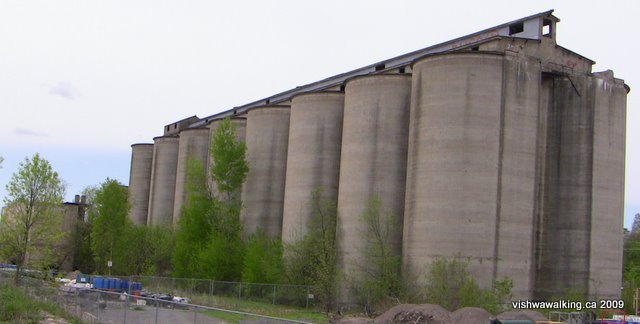 The first Portland cement factory was
built in Owen Sound in 1888 by R. P. Butchart (perhaps: see my Marlbank
cement plant discussion).
The first Portland cement factory was
built in Owen Sound in 1888 by R. P. Butchart (perhaps: see my Marlbank
cement plant discussion).Twelve years later, in 1900, the Lakefield Portland Cement Company was created and operated
independently until 1909.
A view of the kilns from near the stack. The stairs up are at the opposite end. The ultimate objective
is the window at the very top at the end of a long corridor.
Financial difficulties across the industry resulted in the company being sold and incorporated into the Canada Cement Company. It operated under the latter company until its closure in 1932.
A railway was built to carry marl from Buckley's Lake (or Buckley Lake, depending on the map), which is just to the east, to the Lakefield plant. (Information from several sources, but mainly from Colin Churcher's Railway Pages.)
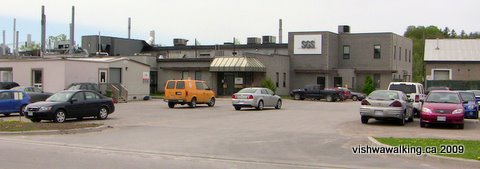
The property is now owned by SGS, a mining research company with offices around the world. SGS Lakefield Research employs 450 people and has been around since 1941.
The SGS offices on Concession Road
The company's description of the Lakefield operation: "Provides comprehensive testing and consulting services in mineral processing, hydrometallurgy, environmental management, mineralogical and diamond services and offers organic and inorganic analytical services. Scope of service ranges from simple bench-scale investigations to fully integrated pilot-plant operations."
In front of the old cement factory is Savage Arms (Canada), which makes guns and employs about 118 people. The Lakefield operation was originally independent and called Lakefield Arms. It started in 1968.
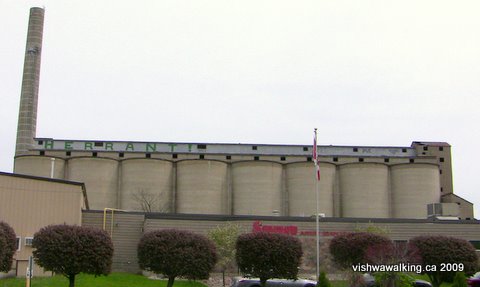 Then in 1989,
Enterprise Canada Ltd. bought the company, subsequently selling it to
Challenger
Industries, a holding company that also owns Savage Arms.
Then in 1989,
Enterprise Canada Ltd. bought the company, subsequently selling it to
Challenger
Industries, a holding company that also owns Savage Arms.In 1995, Savage Arms, now in financial trouble, was bought by Ron Coburn. He changed the name of Lakefield Arms to Savage Arms (Canada). Today, the Lakefield factory exports 95 per cent of its product, mostly to the United States.
Savage Arms (Canada), located on the Water Street side of the plant.
The cement factory is not hard to find in Lakefield. It's huge stack can be seen from most parts of the town
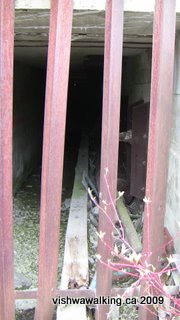 and across the river. It sits between
Concession and Water streets just off County Road #33.
and across the river. It sits between
Concession and Water streets just off County Road #33. It has 16 "kilns" that line up in pairs beside the stack. A fence surrounds most of the property.
The stack is outside the fence and you can walk around it and marvel at its size.
The nearby fence encloses a storage area for SGS, but you can find your way into the kilns easily. The entrances to the kilns are barred with large welded metal strips. However, move along the perimeter and you'll find one open enough to slip through. Inside, the kilns are huge. They would make excellent echo chambers. I stepped on a barrel and the slight sound boomed through the chamber I was in. Another version of Grain Silo #5 in Montreal (see box below)?
Outside view of bars at the
end of the basement tunnel
| Silo #5 grain
elevator, Montréal and the Lakefield cement plant: a comparison Imagine this: The Lakefield cement factory turned into an incredible echo chamber like Silo #5 in Montréal. What a tourist attraction! Internationally-acclaimed musician, R. Murray Schafer (Our Sonic Environment and The Soundscape — the Tuning of the World and other literary works, plus countless compositions) lives just down the road. He could spearhead a fantastic project that would involve musicians, technicians and the public, who, like the Montreal project, could get a hands-on experience creating sounds. It's a natural for Lakefield, which already has a reputation for art events (check out their literary festival in July). After you read the quote below, click on the silophone link and play with the sounds. Then think what possibilities the Lakefield silos could have. Check out Silophone net to hear the grain silo in action. This is from Silophone.net and describes the Silo #5 grain elevator: "Silo #5 is an abandoned grain storage facility in the port of Montréal. A quarter of a mile long and over twenty storys high, it has a total capacity of five million bushels, or enough wheat to make 230 million loaves of bread. "The building was constructed in several stages between 1903 and 1958. The newest part of the building was designed to last for generations, however due to changes in the global grain market and to the general trend of de-industrialization in North America at the end of the 20th century, the building became redundant less than forty years after its completion. "Since 1994, Silo #5 has stood empty, and its fate has been hotly debated. The building is situated in one of Montréal's oldest industrial districts, now rapidly being gentrified and renovated for high-tech commercial, luxury residential, and tourism/leisure industry uses. "The portion of the structure used by Silophone is constructed entirely of reinforced concrete, measures 200 metres long, 16 metres wide and approximately 45 metres at its highest point. The main section of the building is formed of approximately 115 vertical chambers, all 30 metres high and up to 8 metres in diameter. These tall parallel cylinders, whose form evokes the structure of an enormous organ, have exceptional acoustic properties: most notably, a stunning reverberation time of over 20 seconds. "Anything played inside the Silo is euphonized, made beautiful, by the acoustics of the structure. All those who have entered have found it an overwhelming and unforgettable experience." |
Some of the cement silos connect with each other, so you can clamber between them. At the silo you enter, a channel in the centre of the floor needs negotiating. Fortunately someone had conveniently left a barrel that you can climb down onto and then switch to the opposite side to climb up into the the complex.
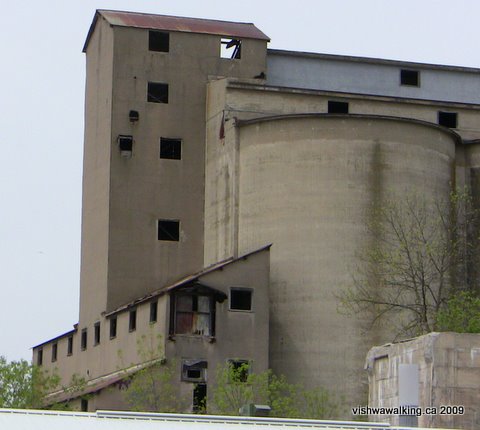 As
interesting as this is, it does not lead to the end building where
there are sets of stairs that allow you to climb to the top of the
structure and see the silos from the top as well as get a bird-eye view
of Lakefield. To do this, requires getting back out of the
silo
section. I very nearly gave up here, but perseverance won in the end.
Part of the challenge of these places is finding the route in; I won't
spoil that for you. Suffice to say, I had to do a bit of climbing.
As
interesting as this is, it does not lead to the end building where
there are sets of stairs that allow you to climb to the top of the
structure and see the silos from the top as well as get a bird-eye view
of Lakefield. To do this, requires getting back out of the
silo
section. I very nearly gave up here, but perseverance won in the end.
Part of the challenge of these places is finding the route in; I won't
spoil that for you. Suffice to say, I had to do a bit of climbing.Inside the end building there are about seven flights of stairs to the top. At the top, a narrow deck runs along the top of the silos.
At the very top floor, a hall runs the length of the silos. Openings provide fine views of the Otonabee River and the town of Lakefield.
The south side of the cement factory. The SGS offices are to the left of this.
Both the deck and the "hall" are high. It goes without saying that it's better to err on the side of caution when negotiating both. The narrow deck especially is no place for those with vertigo.
As you descend, all manner of machinery sits silent, awaiting inspection.
In the basement long tunnels extend under the silos. Here, I presume is where the cement was mixed. Huge auger-like machinery lie in troughs, with bins above that dropped the cement down from the silos, to be throughly mixed.
At the end of the tunnels, the openings are stopped by metal grates. This is perhaps where you started your tour; this time you should be looking from the inside out.
The Lakefield Hydro Dam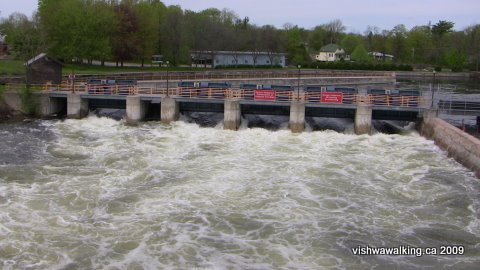 The cement factory went
electric in 1928, using power from the nearby dam on the Otonabee,
which was specifically constructed for the plant. The dam is
now
owned and run by Ontario Power Generation, which has some interesting
information on its site. The cement factory went
electric in 1928, using power from the nearby dam on the Otonabee,
which was specifically constructed for the plant. The dam is
now
owned and run by Ontario Power Generation, which has some interesting
information on its site.The dam looking north from the bridge over the Otonabee River, Lakefield. The dam only served the plant for a few years before it was closed. Canada Cement Company oversaw the construction of the operation. It's not surprising, considering the amount of concrete in the dam and buildings. 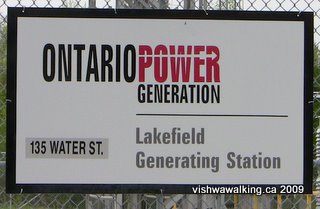 In 1936, the Hydro-Electric Power
Commission of Ontario took it over. In 1936, the Hydro-Electric Power
Commission of Ontario took it over.It has a capacity of 1900 kW of electrical power. It's worth a stroll to Water Street to look at the dam from downstream. Then stroll up to the bridge and have a look at the water as it pours through the dam. |
How to get there: Lakefield is about 14 kilometres from Peterborough, up the Lakefield Road, or up County Road #32 if you want something slightly more picturesque; the latter turns into Water Street. The factory is just off Water Street. Turn east on County Road #33 and you'll see Concession Street running off to your left. The factory is huge and unmistakable with its stack and seven kilns.
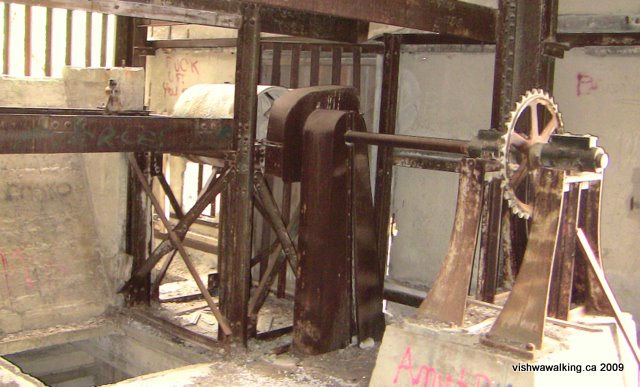
One of the many wheels and axles
at the south end of the building.
Click here or on any photo for more photos
Back to the main Get Lost page
Home | Contact Us | Site Map
Walked:
May 16, 2009
Page created: May 17, 2009
Updated: May 19, 2009
Page created: May 17, 2009
Updated: May 19, 2009
